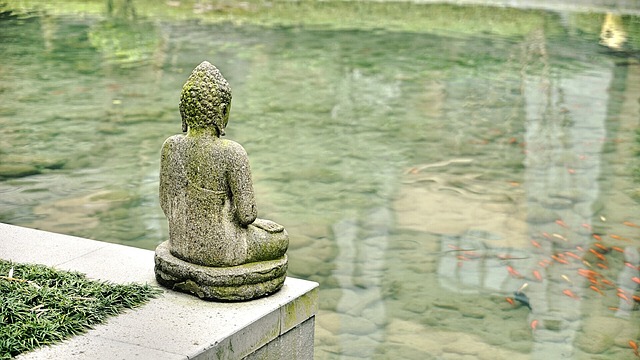by Laura K. Secor

Even people who possess only a passing acquaintance with Buddhism have generally heard of the “Eightfold Path”. In case that’s as far as your acquaintance takes you, this is where the Buddha laid out a step-by-step method of evolving beyond suffering.
These eight practices can be grouped into three types – wisdom, ethics and meditation.
1) right view and right effort are related to our development of wisdom, as they ask one to develop a deep understanding of the way suffering is woven into our experience of reality, and to shape one’s speech and actions thoughtfully.
2) right resolve, right speech, right action, and right livelihood lay out the ethical guidelines expected of any religious teaching.
3) right mindfulness and right concentration provide instruction in meditation.
1. Right View
A true understanding of how reality and suffering are intertwined.
2. Right Resolve
The aspiration to act with correct intention, doing no harm.
3. Right Speech
Abstaining from lying, and divisive or abusive speech.
4. Right Action
Acting in ways that do not cause harm, such as not taking life, not stealing, and not engaging in sexual misconduct.
5. Right Livelihood
Making an ethically sound living, being honest in business dealings.
6. Right Effort
Endeavoring to give rise to skillful thoughts, words, and deeds and renouncing unskillful ones.
7. Right Mindfulness
Being mindful of one’s body, feelings, mind, and mental qualities.
8. Right Concentration
Practicing skillful meditation informed by all of the preceding seven aspects.
And anyone who has taken their yoga practice off the mat has inevitably heard the phrase, “The Eight Limbs of Yoga”. The first confusion arises when deciding how to pronounce Patanjali. It’s fairly easy to spot someone new to esoteric yoga by their enthusiastic stress on the the first and third syllables…. Generally, the next confusion is wondering whether there is any correspondence between Patanjali’s magic eight the Buddha’s magic eight.
The first two limbs of yoga are the ethical guidelines, and the remaining six are all aimed toward the development of a meditative practice. The meditative practice culminates in Samhadi, which is the blissful union with all, and dissolution of individual self.
The eight limbs of yoga according to Patanjali
yamas: restraints, precepts, tenets, guides, compass
niyamas: observances, comportment in the world
āsana: physical postures as preparation for sitting
prānāyāma: moving and controlling the breath
pratyāhāra: withdrawal of the senses
dhārāna: concentration on a focal object
dhyāna: meditation without focal object. Sitting.
samadhi: pure absorption without self
The 8 limbs of yoga map imperfectly upon the eightfold path of Buddhism, but there is a telling resonance. Both include a scant handful of moral precepts and a stong, multi-legged development of the contemplative practices. I think for myself I like a mix-n-match patchwork, including the physical meditation of asana from yoga, and Right View from Buddhism. Right View strikes me as code for the “two wings” of clear seeing and compassion. Those two things, meditative movement and the balancing of brave honesty with brave tenderness, are the core of my personal spiritual practice.
What, then, of the rest of Buddhism? Two major tenets of Buddhism that I struggle with are the lack of boundaries and the dedication of service to others. The scripture most frequently recited by eastern Buddhists – from the Heart Sutra – is “form is emptiness, emptiness is form.” My Western understanding of that riddle is that we are the form, but we are in no way separate from everything else – our form is truly non-existent, or empty.
The western interpretation of Buddhism ties itself into philosophical pretzels trying to incorporate our cult of individuality. Western Buddhism would preserve the self, even while it is apparently dissolved into everything that is not self. However, I am not sure how to reconcile that with eastern Buddhism, which clearly encourages the idea that while we are each a wave, we are all also water. This troubles me, and it seems to also trouble many Westerners. Western Buddhism (Buddhism 4.0?) reassures us that our precious individuality remains intact, that we maintain our separate self in the midst of union. As a card-carrying member of the Individualist Party, this is the interpretation of Buddhism that lets me sleep at night. But I am not sure that this interpretation really embodies the spirit of the original Buddhism.
Another major tenet of Buddhism is the Bodhisattva ideal. The Bodhisattva ideal is personally to achieve enlightenment but then delay transcendence, to stay on this material plane to be of benefit to others. This ideal of service is strongly linked to the dissolution of self. The primacy of others over oneself.
As a youngster, I used to hold those values – wholly porous boundaries and a mentality of service – but as I grow older, I am not so sure. I wrestle with both. But I love trying to think like eastern Buddhists because they aim towards non-dual thinking, which is a fabulous antidote to the relentless Western dichotomies. I would say I enjoy brief swims in the non-dual sea, before I climb out, dry myself carefully and apply my boundaries.
